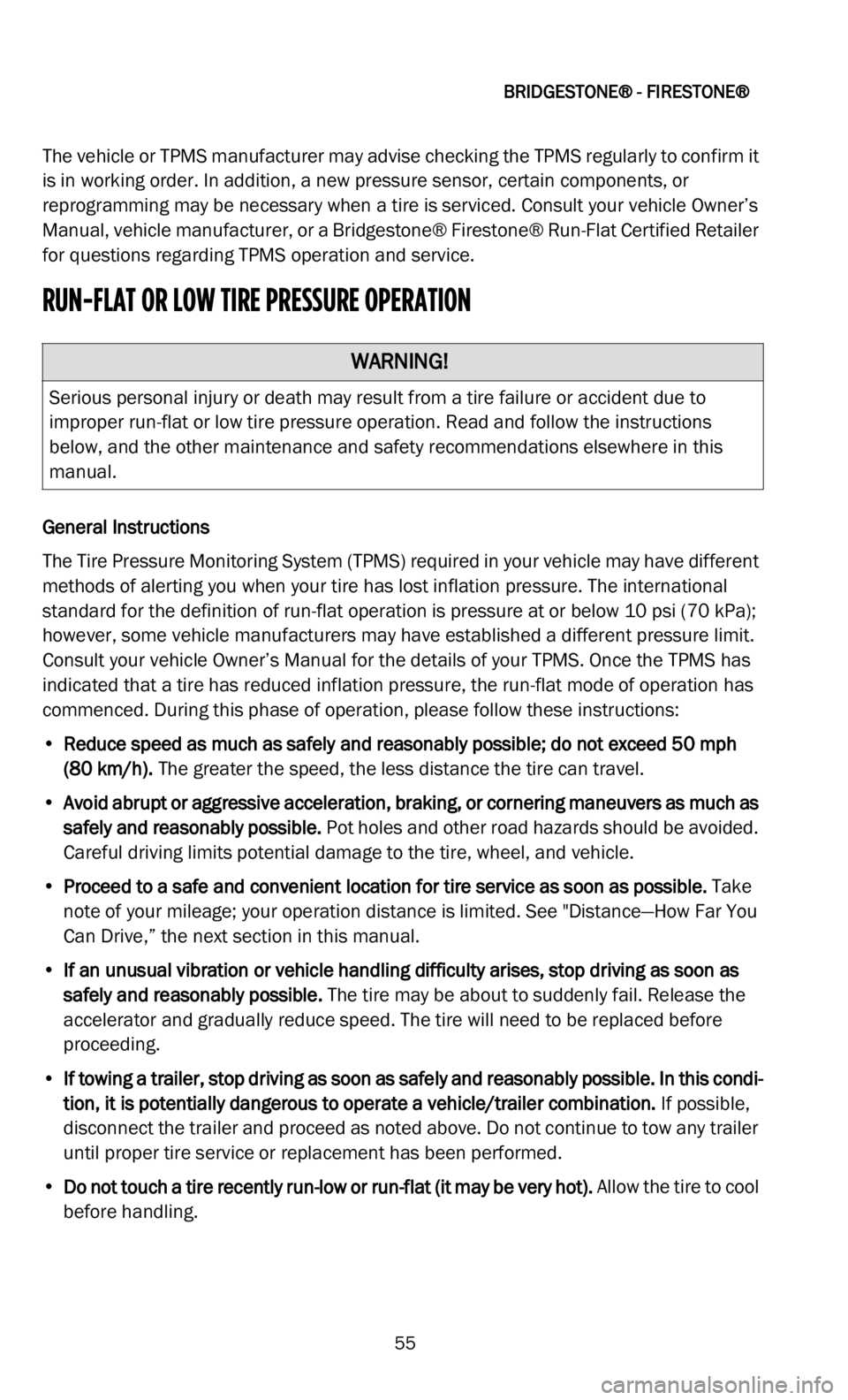sensor DODGE CHALLENGER 2022 Vehicle Warranty
[x] Cancel search | Manufacturer: DODGE, Model Year: 2022, Model line: CHALLENGER, Model: DODGE CHALLENGER 2022Pages: 200, PDF Size: 6.72 MB
Page 56 of 200

BRIDGESTONE® - FIRESTONE®
55
The vehicle or TPMS manufacturer may advise checking the TPMS regularly to confirm it
is in working order. In addition, a new pressure sensor, certain components, or
reprogramming may be necessary when a tire is serviced. Consult your vehicle Owner’s
Manual, vehicle manufacturer, or a Bridgestone® Firestone® Run-Flat Certified Retailer
for questions regarding TPMS operation and service.
RUN-FLAT OR LOW TIRE PRESSURE OPERATION
General Instructions
The Tire Pressure Monitoring System (TPMS) required in your vehicle may have different
m e
thods of alerting you when your tire has lost inflation pressure. The international
standard for the definition of run-flat operation is pressure at or below 10 psi (70 kPa);
however, some vehicle manufacturers may have established a different pressure limit.
Consult your vehicle Owner’s Manual for the details of your TPMS. Once the TPMS has
indicated that a tire has reduced inflation pressure, the run-flat mode of operation has
commenced. During this phase of operation, please follow these instructions:
• Reduce speed as much as safely and reasonably possible; do not exceed 50 m
ph
(8
0 km/h). The greater the speed, the less distance the tire can travel.
• Avoid abrupt or aggressive acceleration, braking, or cornering maneuvers as much as
s
afely and reasonably possible. Pot holes and other road hazards should be avoided.
Careful driving limits potential damage to the tire, wheel, and vehicle.
• Proceed to a safe and convenient location for tire service as soon as possible.
Take
note of your mileage; your operation distance is limited. See "Distance—How Far You
Can Drive,” the next section in this manual.
• If an unusual vibration or vehicle handling difficulty arises, stop driving as soon as
s
afely and reasonably possible. The tire may be about to suddenly fail. Release the
accelerator and gradually reduce speed. The tire will need to be replaced before
proceeding.
• If towing a trailer, stop driving as soon as safely and reasonably possible. In this condi -
t
ion, it is potentially dangerous to operate a vehicle/trailer combination. I
f possible,
disconnect the trailer and proceed as noted above. Do not continue to tow any trailer
until proper tire service or replacement has been performed.
• Do not touch a tire recently run-low or run-flat (it may be very hot).
Allow the tire to cool
before handling.
WARNING!
Serious personal injury or death may result from a tire failure or accident due to
improper run-flat or low tire pressure operation. Read and follow the instructions
below, and the other maintenance and safety recommendations elsewhere in this
manual.
Page 135 of 200

MICHELIN®
134
repair. Any tire repair done without removing the tire from the rim is improper. An
improperly repaired tire will cause further damage to the tire by either leaking air or
allowing air, moisture and contaminants to enter the structure of the tire. An improperly
repaired tire can fail suddenly at a later date.
Never repair a tire with less than 2/32nds of an inch tread remaining. At this tread depth,
th
e tire is worn out and must be replaced.
STORAGE
Tires contain waxes and emollients to protect their outer surfaces from ozone and
weather checking. As the tire rolls and flexes, the waxes and emollients continually
migrate to the surface, replenishing this protection throughout the normal use of the tire.
Consequently, when tires sit outdoors, unused for long periods of time (a month or more)
their surfaces become dry and more susceptible to ozone and weather checking and the
casing becomes susceptible to flat spotting. For this reason, tires should always be
stored in a cool, dry, clean, indoor environment. If storage is for one month or more,
eliminate the weight from the tires by raising the vehicle or by removing the tires from
the vehicle. Failure to store tires in accordance with these instructions could result in
damage to your tires or premature aging of the tires and sudden tire failure.
When tires are stored, be sure they are placed away from sources of heat and ozone such
a s
hot pipes and electric generators. Be sure that surfaces on which tires are stored are
clean and free from grease, gasoline or other substances which could deteriorate the
rubber. Tires exposed to these materials during storage or driving could be subject to
sudden failure.
FOLLOW THESE MOUNTING RECOMMENDATIONS
Tire changing can be dangerous and must be done by professionally trained persons
using proper tools and procedures as specified by the Rubber Manufacturers
Association (RMA). PAX® System tires must be mounted and dismounted only by
specially trained, authorized PAX® System retailers, utilizing PAX® System authorized
equipment.
Your tires should be mounted on wheels of correct size and type and which are in good,
cle
an condition. Wheels that are bent, chipped, rusted (steel wheels) or corroded (alloy
wheels) may cause tire damage. The inside of the tire must be free from foreign material.
Have your retailer check the wheels before mounting new tires. Mismatched tires and
rims can explode during mounting. Also, mismatched tires and rims can result in
dangerous tire failure on the road. If a tire is mounted by error on the wrong-sized rim, do
not remount it on the proper rim, scrap it. It may have been damaged internally (which is
not externally visible) by having been dangerously stretched and could fail on the
highway.
Old valves may leak. When new tubeless tires are mounted, have new valves of the
c o
rrect type installed. Tubeless tires must only be mounted on wheels designed for
tubeless tires i.e., wheels which have safety humps or ledges. As with any other tire air
valve, the PAX® System valve stem-pressure sensor combination must be in good
Page 136 of 200

MICHELIN®
135
condition to assure its performance. Always utilize valve caps capable of containing the
tire’s air pressure, should the valve core leak. The valve cap is the primary seal against
air loss.
It is recommended that you have your tires and wheels balanced. Tires and wheels which
a r
e not balanced may cause steering difficulties, a bumpy ride, and irregular tire wear.
SPECIAL MOUNTING INSTRUCTIONS FOR PAX® SYSTEM TIRES
PAX® System wheels are different from all other wheels. Never attempt to mount a
non-PAX® System tire on a PAX® System wheel, or a PAX® System tire on a non-PAX®
System wheel. Attempting to do so could cause serious injury or death. All PAX® System
components (tire, wheel, support ring, pressure sensor and gel) must be utilized. Never
utilize a PAX® System tire and wheel without every other properly functioning component
part, correctly installed by an Authorized PAX® System retailer. The PAX® System must
be used on all wheel positions.
After a low or zero pressure driving event, the PAX® System tire and wheel may be hot to
th
e touch. Always allow a PAX® System tire to cool before attempting to handle it. Failure
to do so could result in injury.
SPECIAL MOUNTING INSTRUCTIONS FOR SELF-SUPPORTING ZERO PRESSURE™ (ZP)
T I
RES
ZP tires can be more difficult to mount than conventional tires. They should be mounted
a n
d demounted only by a properly trained tire professional. ZP tires can generate a
tremendous amount of heat when run at low or zero pressure. ALWAYS ALLOW A ZP TIRE
TO COOL BEFORE ATTEMPTING TO HANDLE IT. FAILURE TO DO SO COULD RESULT IN
INJURY.
MICHELIN® ZP tires are tubeless tires designed to operate in emergency conditions at
lo
w or zero air pressure.
MICHELIN® SELF SUPPORTING Zero Pressure™ (ZP) TIRES AND SPECIAL SYMMETRIC
H U
MP-MODIFIED (SH-M) WHEELS
Some MICHELIN® ZP tires can only perform with zero pressure capability when mounted
o n
special SH-M wheels. These tires bear the SH-M designation immediately following
the ZP designation on the sidewall of the tire. DO NOT MOUNT ZP TIRES WITH THE SH-M
DESIGNATION ON STANDARD WHEELS. IN SUCH APPLICATIONS, THE TIRES MAY
BECOME UNSERVICEABLE AT LOW OR ZERO PRESSURE, CAUSING SERIOUS PERSONAL
INJURY OR DEATH.
SPECIAL MOUNTING INSTRUCTIONS FOR MICHELIN® TRX™ TIRES
The MICHELIN® TRX™ tire is a tubeless tire that must only be mounted on special wheels
( T
R or JM type) with millimetric seat diameter. If TRX tires are mounted on standard
wheels, they will not retain air due to an air escape feature designed into the bead area
of these tires.
Do not try to override this feature by mounting TRX tires with tubes. The MICHELIN®
T R
X™ tire must be used on all wheel positions.